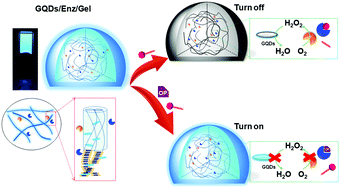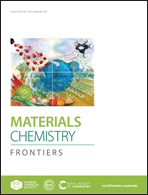Enhancement of sensitivity for dichlorvos detection by a low-weight gelator based on bolaamphiphile amino acid derivatives decorated with a hybrid graphene quantum dot/enzyme/hydrogel†
Abstract
Developing the sensitivity of an optical biosensor motivates the exploration of an amplification strategy for the incorporation of a biosensor system in a supramolecular hydrogel. We developed novel fluorescent hybrid materials comprising graphene quantum dots and enzymes supported by L-phenylalanine derived bis(urea) supramolecular hydrogels (GQDs/Enz/Gels) for detection of organophosphates. The addition of acetylcholinesterase (AChE) and choline oxidase (ChOx) during the formation of self-assembled GQDs/Gel materials resulted in enzyme-functionalized gel networks. Significant turn-off fluorescence of the encapsulated GQDs in the hydrogels was due to hydrogen peroxide generated from the active enzymatic reaction. The addition of insecticide dichlorvos to the GQDs/Enz/Gels resulted in the recovery of fluorescence in proportion to the concentration of dichlorvos, with a detection limit of 2.61 × 10−8 M which outperforms those in solution by 100-fold improvement and a wider linear range of 1.25 × 10−8–1.25 × 10−4 M compared to those of the biosensor in solution. These hybrid hydrogels show promising sensitivity to the detection of oxy-form organophosphate pesticides and expectedly offer scope for the development of rapid and environmentally friendly techniques.



 Please wait while we load your content...
Please wait while we load your content...